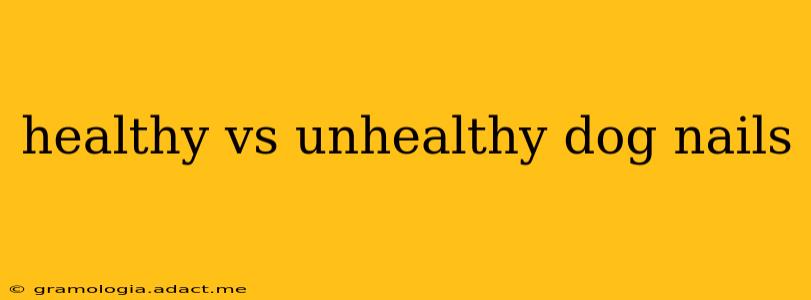Keeping your canine companion healthy involves more than just diet and exercise; it also includes regular nail care. Understanding the difference between healthy and unhealthy dog nails is crucial for preventing pain, discomfort, and potential infections. This guide will delve into the characteristics of both, helping you identify problems early and maintain your dog's paw-some well-being.
What Do Healthy Dog Nails Look Like?
Healthy dog nails are typically smooth, hard, and slightly curved. The color varies depending on your dog's breed and coat color, ranging from light beige or pink to almost black. However, regardless of color, a healthy nail will be free of cracks, splits, or discoloration. You should be able to gently press on the nail without causing any pain or bleeding. The quick (the pink part of the nail containing blood vessels and nerves) should be easily visible, but not excessively long or close to the end of the nail. Finally, healthy nails should be strong and resilient, not brittle or easily broken.
Signs of Unhealthy Dog Nails
Several signs indicate your dog's nails might be unhealthy. These include:
- Brittle or splitting nails: This often indicates a nutritional deficiency or underlying health issue.
- Discolored nails: Yellowing, browning, or darkening can signify infection, trauma, or even certain diseases.
- Thickened or overgrown nails: Long nails can curl under, causing discomfort, pain, and even lameness. Overgrown nails are particularly prone to cracking and infection.
- Bleeding nails: This is a clear sign of injury or improper trimming.
- Lameness or limping: A dog experiencing pain from its nails may show signs of lameness.
- Swelling or inflammation around the nails: This could indicate an infection or other issue.
- Excessive licking or chewing of the paws: This may be a sign that your dog is experiencing discomfort in their paws, possibly related to their nails.
How Often Should I Trim My Dog's Nails?
The frequency of nail trims depends on your dog's activity level and the rate of nail growth. Generally, most dogs require nail trims every 2-4 weeks. However, if your dog spends a lot of time on hard surfaces, their nails may wear down naturally, requiring less frequent trims. If you are unsure, consult your veterinarian.
What if My Dog's Nails are Unhealthy?
If you notice any signs of unhealthy nails, it's crucial to consult your veterinarian. They can determine the underlying cause and recommend the appropriate treatment. This might involve dietary changes, medication, or more frequent nail trims performed by a professional. In some cases, your vet may need to perform a nail amputation in extreme cases. Ignoring unhealthy nails can lead to significant pain, infection, and long-term health problems for your dog.
Can I Use Human Nail Clippers on My Dog?
No, you should never use human nail clippers on your dog. Dog nails are much thicker and tougher, and human clippers are not designed for this purpose. Using the wrong tools can lead to cracked, broken, or bleeding nails, causing pain and distress.
How Do I Prevent Unhealthy Dog Nails?
Prevention is key to maintaining healthy dog nails. This involves:
- Regular nail trims: Schedule regular trimming to avoid overgrowth.
- Proper diet: Ensure your dog's diet is rich in essential nutrients for healthy nail growth.
- Exercise: Adequate exercise helps to wear down nails naturally.
- Paw protection: Consider using paw protection during walks on rough terrain.
By following these simple tips, you can significantly reduce the risk of unhealthy nails and ensure your canine companion remains comfortable and pain-free. Regular nail care is a simple yet crucial aspect of responsible pet ownership. Remember, a happy dog often starts with healthy paws!
